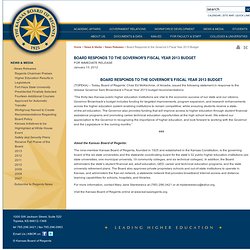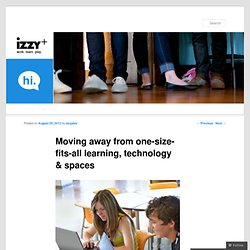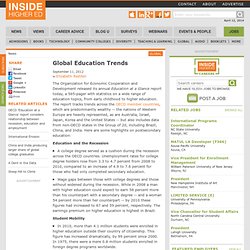

Survey of Faculty: Prof & Technology, 2012. Professors occasionally get lampooned as luddites responsible for the famously slow pace of change in higher education.

But in truth the majority of professors are excited about various technology-driven trends in higher education, including the growth of e-textbooks and digital library collections, the increased use of data monitoring as a way to track student performance along with their own, and the increasingly popular idea of “flipping the classroom.” However, other technology trends are more likely to make professors break into a clammy sweat. These include the proliferation of scholarship outlets operating outside the traditional model for peer review, the growth of for-profit education, and the intensity of digital communications.
These are some of the findings in the second of two reports from surveys conducted by Inside Higher Ed and the Babson Survey Research Group. The first report, focusing on faculty views of online education, was published in June. Green College Quiz. Guideto311GreenColleges. What makes a campus green? Example of Campus Sustainability Plan. Campus Sustainability Practices. Generation Y - Characteristics of Generation Y. Born in the mid-1980's and later, Generation Y legal professionals are in their 20s and are just entering the workforce.

With numbers estimated as high as 70 million, Generation Y (also known as the Millennials) is the fastest growing segment of today’s workforce. As law firms compete for available talent, employers cannot ignore the needs, desires and attitudes of this vast generation. Below are a few common traits that define Generation Y. Board Responds to the Governor's Fiscal Year 2013 Budget. FOR IMMEDIATE RELEASE January 13, 2012 (TOPEKA) – Today, Board of Regents’ Chair Ed McKechnie, of Arcadia, issued the following statement in response to the release Governor Sam Brownback’s Fiscal Year 2013 budget recommendations: “The thirty-two Kansas public higher education institutions are vital to the economic success of our state and our citizens.

Governor Brownback’s budget includes funding for targeted improvements, program expansion, and research enhancements across the higher education system enabling institutions to remain competitive, while ensuring students receive a state-of-the-art education. The Governor also provides funding that will improve access to higher education through student financial assistance programs and promoting career technical education opportunities at the high school level. Kansas Board of Regents. From Adventure to Zilch. How Steelcase Redesigned the 21st Century College Classroom. When it comes to creative office spaces, "collaboration" and "flexibility" are the bywords of the moment.

KI Education - Flexible Furniture. In our experience with furnishing K-12 schools, we’ve found there are significant benefits to creating learning environments about which students and their parents feel ownership.

KI Education - ARTICLES. In our experience with furnishing K-12 schools, we’ve found there are significant benefits to creating learning environments about which students and their parents feel ownership.

For this reason, many schools are specifying educational furniture that helps set the school apart – and attract students. Our educational furniture can help you do just that. KI Education Furniture Solutions Transform Pan American Academy Charter School. New classroom furniture facilitates 21st-century instruction. Moving away from one-size-fits-all learning, technology & spaces. What does the future of learning look like?

In the minds of many, it looks high tech and new—a complex array of technology and apps waiting to be woven into traditional curricula and classrooms. Others believe the future of learning should more closely mimic the ways people learned long ago—more collaboration, more Socratic dialogue, and more opportunities for hands-on discovery. At izzy+, we think the key is balancing the two—utilizing time-tested person-to-person learning approaches, along with the best advances technology has to offer. The Interactive Future of Higher Education. Educating Our Way to a Better Future. A high school education is not enough in today’s global economy—this much we know.

By the end of this decade, more than 60 percent of all jobs will require some kind of education beyond high school. The problem is that today’s college system is not setting students up to succeed. Nontraditional is the new traditional at America’s community colleges—most students work while attending classes, have dependents of their own, enroll in college part time, and are financially independent. 60 percent of college students are not college ready, testing into remedial level courses, delaying their ability to enter a program of study and complete a degree or credential. Only about half of all Americans earn some form of degree after high school. That figure drops to 25 percent for low-income students. Top_trends_in_Education_White_Paper. Global Education Trends. The Organization for Economic Cooperation and Development released its annual Education at a Glance report today, a 565-pager with statistics on a wide range of education topics, from early childhood to higher education.

The report tracks trends across the OECD member countries, which are predominantly wealthy -- the nations of Western Europe are heavily represented, as are Australia, Israel, Japan, Korea and the United States -- but also includes data from non-OECD states in the Group of 20, including Brazil, China, and India. Here are some highlights on postsecondary education: Education and the Recession A college degree served as a cushion during the recession across the OECD countries.
Unemployment rates for college degree holders rose from 3.3 to 4.7 percent from 2008 to 2010, compared to an increase of 4.9 to 7.6 percent for those who had only completed secondary education. Student Mobility. What is 21st Century Education. Revised August 2008.

Your Assignment, Should You Choose to Accept It . . . Like Alice, many educators, policy makers and even the general public respond resoundingly with "That's impossible! " when challenged to adopt a new paradigm of education for the 21st century. Most people today adhere to a paradigm of education that is strictly 19th century.
21st-Century Learner. The 21st-century learner is here–is your classroom ready? By Mark Stevens NEA members attending this year's RA got a look at technology that could transform teaching and learning in their classrooms.Photo by Calvin Knight No one sees more clearly than educators how the technologies we use in our daily lives influence how students learn. What Does a 21st Century Learner Look Like? So often we hear the phrase “21st Century Learner,” but what does that actually mean? This exact question was asked of me by one of my professors awhile back and I admit, it caught me off guard. Not only was I put on the spot, but I too pondered the same question for quite some time. The only truthful way I knew to go about answering this question was to draw on my own experience and intuition.
21 Signs You’re a 21st Century Teacher. Are you a 21st Century Teacher? Find out! PLUS if you can help me add to my list you may win a special $200 prize. Keep reading to find out how... 1. You require your students to use a variety of sources for their research projects...and they cite blogs, podcasts, and interviews they've conducted via Skype. 2. 3. 4. Designing Colleges For More Than Just Connectivity. While it’s counterintuitive to think of today’s college students as anything other than techno-savants thriving in a hyperconnected campus, I would like to pose a softer, gentler perspective on what these students think really matters and what seems to be getting lost in all the fiber-noise: their individuality. Case in point: Students today largely are not finding what they need and crave as individuals in the physical design of today’s campus.
They’re not finding classrooms that inspire them, environments that support collaboration with their peers and teachers, and quiet places to actually get the work done. Gensler, the global design firm where I practice, recently spent a semester surveying more than 250 undergrad and graduate students from around the country in an effort to better understand exactly how and where they spend their study time on campus, and whether those physical spaces (classrooms, labs, libraries, in-between spaces) effectively support their needs.